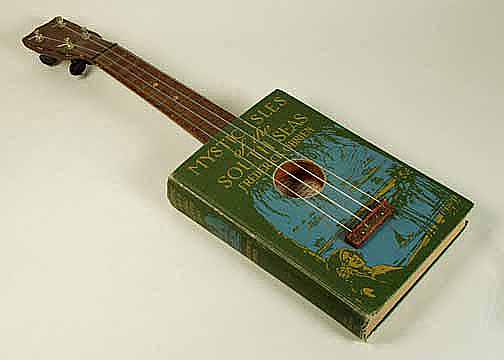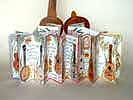
Ukulele Books
by Peter and Donna Thomas
![]() 260 Fifteenth Avenue Santa Cruz CA 95062 (831)
515-2757
260 Fifteenth Avenue Santa Cruz CA 95062 (831)
515-2757
To contact Peter and Donna use this email address: peteranddonna
( ) cruzio.com
You will have to type in the @.
![]()

Ukulele Books
by Peter and Donna Thomas
![]() 260 Fifteenth Avenue Santa Cruz CA 95062 (831)
515-2757
260 Fifteenth Avenue Santa Cruz CA 95062 (831)
515-2757
To contact Peter and Donna use this email address: peteranddonna
( ) cruzio.com
You will have to type in the @.
![]()
Ukulele Books
One day I thought to myself, "I love to make books and I love to play the ukulele. How can I put these two loves together? Can I make a book out of a uke?" I made the first by cutting pages from a Sunset Travel Guide into the shape of a ukulele. I did it with pinking shears as a reference to the pineapple on the cover of the magazine. I then stacked the pages, drilled a hole through them and screwed them to the back of a ukulele. The pages opened as a fan, and I imagined hitchhiking around Hawaii with my ukulele book, playing a song when I got dropped off, then browsing the pages to decide where I would go next. After Donna and I made this first ukulele book, I thought, "How many more can we make? Each one will have to represent a different book structure, format or concept and each will still have to play....
All ukulele books measure approximately 18 by 6 by 3 inches.
| Ukulele Series Book #1: The Ukulele Fanbook.
1996 This was made using my first ukulele, the one my brother gave me when he said, "Let's both get ukes so we can play with dad and be like a Partridge Family." The fan book binding structure originated in Southeast Asia. We had to develop a variation on the traditional structure to make it work with a ukulele. Pages were cut from a Sunset Travel Guide to Hawaii, then trimmed with pinking shears to give them the feeling of a pineapple. A uke shaped cover was made using tapa cloth, then pages and cover were screwed to the back of the ukulele, into the heal of the neck. $1650. More images. |
|
| Ukulele Series Book #2: The Ukulele Accordion.
1996 |
|
 |
Ukulele Series Book #3: The Altered Ukulele
book. 1999 This copy was created based on ideas explored in 1997 when making an earlier collaged ukulele for the private collection of Ukulele Dick. Pages from Jim Beloff’s A Visual History of the Ukulele were cut up and collaged onto a tourist ukulele I bought in Honolulu. The text explains the meaning of the word "ukulele", and is found pasted to the fret board, under the strings. $1500. More images. |
 |
Ukulele Series Book #4: The Ukulele Bookshelf.
1998 A bookshelf was built inside the body of the ukulele, under the sound hole. The bookshelf holds twelve miniature books, full bound in three different colors of leather. Each is stamped with a letter and when lined up they read UKULELEBOOKS. There are four books per color binding, and when all copies of the same color are opened and lined up, one full page spread from the book A Visual History of the Ukulele is revealed. $1650. More images. |
 |
Ukulele Series Book #5: The Faux Book Ukulele.
1999 This ukulele book is covered using bookbinding materials: marbled paper is affixed to the top, headband material mimics rope binding around the sound hole, leather with raised bands covers one side as a spine and the other side is covered with deckle edges of handmade paper. The ukulele features a painted by Sheryl McCartney of Santa Cruz, California. $1650. More images. |
 |
Ukulele Series Book #6: I'm a Fan of the Ukulele.
2000 This vintage, but originally inexpensive, ukulele made in Japan was sawed in half, ukulele shaped boards were attached to the open end of each half, making two solid half ukuleles. Pages were handmade to match the shape of this specific ukulele, letterpress printed with the words, "I'm a Fan of the Ukulele" and attached by screw post to the back half of the uke. Each page has the autograph of a famous ukulele player. $4850. More images. |
 |
Ukulele Series Book #7: The Fanned Foredge
Ukulele. 2000 This ukulele belonged to a friend's young daughter and he gave it to me to end her incessant strumming. The ukulele was sawed in half, boards were attached to the open end of each half to make two solid half ukuleles, and the sound hole was drilled all the way through the front half. Paper was handmade to the profile of the ukulele. The paper was stacked, drilled to create a hole that matched the ukuleles sound hole, then each consecutive circle was cut, by hand, a little larger to create a fanned appearance. The ukulele, and all the pages were painted in deep blue colors by Suzanne Thomas, then Donna Thomas wrote the text, the lyrics to the song Blue Hawaii, on the pages, and painted the title over the concentric circle cut outs so it appeared to be a fanned out foredge painting. The pages were then attached between the two half ukuleles using a post screw. $1850. More images. |
 |
Ukulele Series Book #8: A copy of Mystic Isles of the South Seas by Fredrick O'Brien was modified internally so that the neck of a ukulele could be attached inside, making the book function as the body of a ukulele. A sound hole was drilled through the cover and a bridge mounted on the cover below the sound hole. The book opens at the back cover, so the title page of the book was removed from the front and pasted at the back, so it could still be read. $1750. More images. |
 |
Ukulele Series Book #9: The Letterpress Ukulele.
2002 This ukulele was a rejected prototype concert ukulele made for Lehua Ukuleles. It was sawed in half and boards were attached to the open end of each half to make two half ukuleles. Pages were handmade in the shape of two ukuleles attached at the sides, allowing the pages to be folded and then sewn together through the folds. The handmade paper pages were letterpress printed in various colors of ink, with the word ukulele in various fonts of wood type and two of Donna's linocuts of ukuleles. The book was sewn with two needles over tapes, made of brass wrapped in leather. These tapes were connected to brass hinges on each end and the hinges used to connect the front and back half of the ukulele. $2200. More images. |
 |
Ukulele Series Book #10: The Scrolling
Ukulele. 2002 |
 |
Ukulele Series Book #11: The Concertina
Ukulele. 2002. |
 |
Ukulele Series Book #12: This soprano ukulele was one of ten made in Mexico as production prototypes for Uke Brand Ukuleles of Felton, California. They were flawed, with the neck angled the wrong way, so were discarded. The ukulele was sawed in half, boards attached inside the open ends, making two half ukuleles, each with a small recessed chamber. The two halves are attached at the heal using a hidden barrel hinge, which allows the ukulele open like a counterbalanced clamshell. The text is composed of a dozen vintage glassine string envelopes, mounted in slots cut in wood dowels, as newspapers were held in libraries. The dowels are inserted through holes drilled in a wood ‘flap book’ framework, and knobs are attached to each end to aid in turning the pages. $1950. More images. |
 |
Ukulele Series Book #13: The Ukulele Jam.
2002 This ukulele was once part of a calliope. It had holes drilled through the neck and fret board for the chording mechanics, and triple high action to accommodate mechanical strikers, making it useless as a personal instrument. It was sawed in half lengthwise, through the sound hole. The halves rebuilt to create small chambers, then attached by hinges on the back. A hasp screwed on the back of the headstock holds it shut. A tall narrow Coptic bound book, with Moroccan leather covered boards, each with a colored leather onlay of a ukulele player, is inserted in the chamber. The text is a "exquisite corpse" picture book, where horizontally slit pages create interchangeable heads, torsos and legs for fifteen different images of ukulele players painted by Donna. $2500. More images. |
 |
Ukulele Series Book #14: Old Ukes. 2001 |
 |
Ukulele Series Book #15: The Cabinet of Curiosities
- Cigar Box Ukulele. 2002 Since the days of the jug bands people have been making ukuleles with cigar boxes. And since cigars started to be sold in boxes, artists have used those boxes. In this case, an old soprano ukulele neck was attached to a small cigar box. Inside the cigar box is a diorama that tells a story about the historical allure Hawaii has, as the archetype of tropical paradise. Book artists’ often consider creating dioramas as books because of the way they tell a story, a story that can be different for each viewer. $1650. More images. |
 |
Ukulele Series Book #16: The Jacob's Ladder
Ukulele Book. 2002 A section from the back of this ukulele’s neck was cut away, creating space for a book to be affixed, while still allowing the ukulele to be played. A book with a ‘Jacob's ladder’ structure, constructed of koa wood, covered with letterpress printed paper panels, and connected by black satin ribbon, is attached to the neck. The section of neck that had been removed is attached to the other end of the Jacob’s ladder as a back cover, and a ukulele capo is used to hold the book shut. In Hawaiian, ladder is often translated as "the way of spaces" and the text we have used is from Davida Malo's 1898 edition of Ka Moolelo Hawaii, where he discusses the naming of the upper and lower spaces. $1650. More images. |
 |
Ukulele Series Book #17: The Duke Uke. 2002
A Duke Kahanamouku ukulele was cut in half. Those halves were attached to the front and back covers of a commercial book titled The Duke by Joseph Brennan, which is a biography of Duke Kahanamouku. A case, made to look like Duke's iconic surfboard, was constructed to house this book. $3000. More images |
 |
Ukulele Series Book #18: The Shaped Book Ukulele.
2003 The ukulele was sawed lengthwise, in thirds, and rebuilt like a bent wood "shaker" box, affixing the middle third of the ukulele as a band around the back third of the ukulele so it could be used as a lid on the bottom third of the uke. A copy of Hawaii: Isles of Dreams by Jacques Chegaray was cut to the shape of the ukulele and is housed inside. $1650. More images. |
 |
Ukulele Series Book #19: The Ukulele Tunnel
Book. 2003 This ukulele houses a tunnel book that is viewed through the sound hole. The ukulele was sawed lengthwise, very close to the back, leaving a large open chamber in the front half. The front was rebuilt with an inner back with a sound hole drilled through it. A tunnel book, showcasing lyrics to the song Little Brown Gal, with handwritten text and hand colored images, is attached to the inside of the front and back halves. The two halves are held together by three little brass clasps mounded on the sides and bottom.$1850. More images. |
 |
Ukulele Series Book #20: The Ukulele Flip
Book. 2003 This Regal ukulele houses a flipbook that is viewed through the sound hole. The flipbook, caricaturizing a Hawaiian Island visitor’s dream of paradise, is an animated hula dancer, created for the project by Evert Brown of Boulder, Colorado. The flipbook pages are inserted in slots cut lengthwise in a wooden dowel. The dowel passes through a hole in the side of the ukulele; a brass crank handle is attached at one end of the dowel. As the crank is turned the pages brush against the sound hole causing them to flip and thus creating the motion of a swaying hula dancer. $1900. More images. |
 |
Ukulele Series Book #21: The History of the
Ukulele Cigar Box Ukulele. 2002. Our first cigar box ukulele was made with a wooden cigar box that was proportionally too small for the neck, so when I fell in love with the patina of age on this cardboard cigar box I decided to make another, where the proportions would more closely matched those of a standard ukulele. I had bought the ukulele neck from Bernuzio Brothers in 1994, thinking I would use it make a ukulele. I didn't realize the challenge I was going to have attaching it to a cardboard (instead of wood) cigar box. Challenges overcome, I built a diorama inside the cigar box, a tropical scene that includes a hidden copy our miniature book A Brief History of the Ukulele [A119}. $2500. More images. |
 |
Ukulele Series Book #22: The Ukulele Sheet
Music Book. 2002 The ukulele was sawed in half and larger koa wood boards were attached to the cut edges of each half, creating two half ukuleles that were used for the covers of this book. Vintage sheet music pages, featuring Hawaiian themed songs with printed ukulele chords, are held in plastic sleeves. The sleeves are sewn to a pleated paper spine, and Coptic bound between the two covers. A shaped wooden box was made to hold this ukulele book. $2650. More images. |
 |
Ukulele Series Book #23: A
Brief History of the Ukulele. 2003. |
 |
Ukulele Series Book #24 The Photo Album Uke. 2014. This six string Mexican ukulele (or perhaps really a miniature guitar) was sawed in half, the inside of the top and back then braced with rosewood strips, and the two halfs hinged at the spine. Photographs were mounted on black matt board and glued to the braces inside each half. Sold. More images. |
 |
Study number 1 for uncompleted Ukulele Series book: This is a study for a palm leaf binding in the neck of a ukulele. 2000 The neck with the palm leaf book structure and the covers with the blank pages sewn in. $450. More images. |
 |
Study number 2 for uncompleted Ukulele Series book: This is a study for a coptic binding with old top and back of a ukulele. 2001 Double ukulele shaped paper is folded in half and coptic stitched into covers from an old concert sized Kamaka ukulele. $450. More images. |
See our gypsy wagon
See the Wandering Book Artists' Collaborative Broadside Series